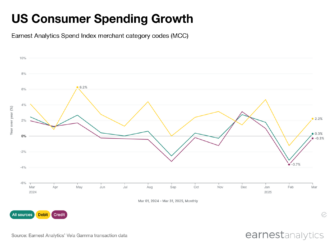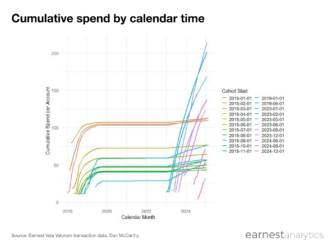Alternative Data: What is It & How Can It Help Consumer Brands and Investors?
By Andrew Robson, President & CRO, Earnest Analytics (FKA Earnest Research)
Much like today’s throwaway phrases such as Machine Learning and Neural Networks, Big Data was, and continues to be, uttered by many and understood by few. Increasingly, however, companies large and small are harnessing insights gleaned from massive data sets for better strategic decision-making. Alternative Data, an emerging category within Big Data, is capturing both the mind- and wallet-share of operators and investors alike.
Alternative Data describes data that, until very recently, has not been leveraged to provide insights on consumers, companies, and industries. Through increased availability and adoption of hardware and software like mobile handsets, digital banking, and low-cost satellite imagery, there has been exponential growth in digital footprints generated by people and companies: Satellites count cars in parking lots, handsets are beacons of their owners’ locations, and consumers leave digital breadcrumbs with each credit card swipe. Ever-cheaper cloud storage and powerful processing technology have made it economically viable for both incumbent and startup analytics firms to mine alternative data for valuable insights.
Corporations, investors, and startups use these new capabilities to better understand consumer behavior and business performance. For example, retailers typically have an abundance of information on their customers’ activity within their store, but have little-to-no insight into where their customers go and what they purchase before and after shopping with them. Alternative data offers the ability to provide 360 degree visibility into their customer’s journey — both inside and outside their stores — as well as near real-time intelligence on how their competitors are performing, often down to store-level granularity.
Transaction Data
Traditional tools for understanding customer behavior, such as surveys, are often limited, inefficient, and biased. Consumer transaction data provides hard, behavioral evidence of consumer preferences as manifest through their actual purchasing history.
While consumer transaction data (credit and debit card transactions) has long been used by brands to understand industry trends, only recently has alternative data been leveraged to power more granular insights for retailers, restaurants, e-commerce brands, and investors. Using anonymous, aggregated consumer transaction data, brands are now able to dive deeper into their customers’ full wallets and also gain competitive intelligence on individual competitors, rather than an index or basket of competitors. For example, Taco Bell executives can see where else their customers dine, where they shop for clothing and which specialty retailers they frequent, all at the brand level.
Other capabilities include customer segmentation by online and offline spend. By understanding cross-channel differences in repeat purchase rates and customer lifetime value, companies can answer questions such as: How much should I spend to acquire an online customer vs. in-store customer? How are their overall brand preferences different from one another?
Regional dynamics can be observed down to the store level. A new fast casual concept can study customer migration in Dupont Circle in D.C. to decide where to open their next location, as well as to benchmark against other fast casual competitors in the same area. Domino’s and Pizza Hut can quantify their share of the pizza market down to city-level granularity and be alerted to when new competitors come into a market.
By observing an aggregate panel of anonymous consistent shoppers, business leaders can track their customers’ behavior as they discover new brands and frequent competitors. JC Penney executives may have data on what their customers are buying and how much their most loyal customers spend, but without the right data, they can’t answer more complex questions, such as: What happens to my most loyal customers’ spend after they sign up for Amazon Prime?
When used correctly, data can transform how people make decisions about their business. Companies utilizing alternative data sources such as transaction data will lead their industries, connecting analytics to action and leveraging a competitive information advantage.











